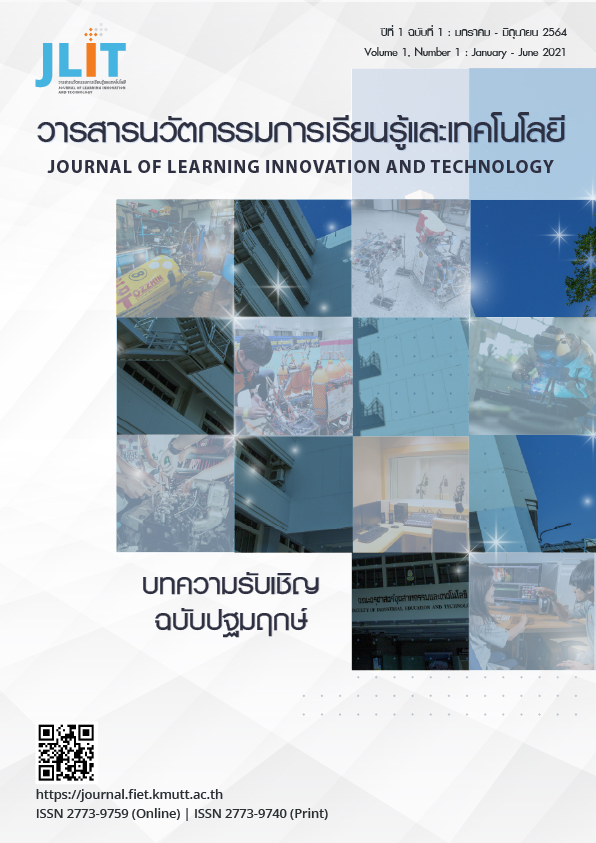การประยุกต์ใช้เทคโนโลยีนวัตกรรมพลังงานแสงอาทิตย์เชื่อมต่อกับระบบจำหน่ายไฟฟ้า
คำสำคัญ:
โฟโตโวตาอิค, ความเข้มแสง, ร้อยละอัตราส่วนประสิทธิภาพ, กำลังการผลิตกระแสไฟฟ้าบทคัดย่อ
บทความวิจัยนี้นำเสนอการประยุกต์ใช้เทคโนโลยีนวัตกรรมพลังงานแสงอาทิตย์เชื่อมต่อกับระบบจำหน่ายไฟฟ้า ซึ่งการส่งกำลังไฟฟ้าด้วยพลังงานแสงอาทิตย์ขนาดเล็กแบบกระจายตัวเชื่อมต่อกับระบบจำหน่ายไฟฟ้า ด้วยโปรแกรมแบบจำลองทางคณิตศาสตร์ PVSyst และมาตรฐาน IEC 61724 โดยมีวัตถุประสงค์หลักเพื่อศึกษาร้อยละอัตราส่วนประสิทธิภาพจากการประยุกต์ใช้เทคโนโลยีนวัตกรรมพลังงานแสงอาทิตย์เชื่อมต่อกับระบบจำหน่ายไฟฟ้า ผลจากการศึกษาพบว่าการประยุกต์ใช้เทคโนโลยีนวัตกรรมพลังงานแสงอาทิตย์เชื่อมต่อกับระบบจำหน่ายไฟฟ้า สามารถผลิตกระแสไฟฟ้าได้สูงสุดและมีความต่อเนื่อง รวมทั้งเพิ่มประสิทธิภาพพลังงานไฟฟ้ากับระบบจำหน่ายไฟฟ้า
เอกสารอ้างอิง
S. Chalmers, M. Hitt, J. Underhill, P. Anderson, P. Vogt and R. Ingersoll, “The Effect of Photovoltaic Power Generation on Utility Operation,” IEEE Transactions on Power Apparatus and Systems, vol. PAS-104, no.3, pp.524–530, 1985.
N. Patapoff and D. Mattijetz, “Utility Interconnection Experience with an Operating Central Station MW-Sized Photovoltaic Plant,” IEEE Transactions on Power Systems and Apparatus, vol. PAS-104, no.8, pp.2020–2024, 1985.
M.E. Ropp, K. Aaker, J. Haigh and N. Sabbah, “Using Power Line Carrier Communications to Prevent Islanding,” In Proceedings of the 28th IEEE Photovoltaic Specialists Conference, pp.1675–1678, 2000.
J. S. Savier and D. Das, “Impact of network reconfiguration on loss allocation of radial distribution systems,” IEEE Trans. on Power Delivery, vol.22, no.4, pp.2473-2480, 2007.
P. Ngamprasert, P. Wannakarn and N. Rugthaicharoencheep, “Assessing the Power Generation Potential DC from Photovoltaic Power Plants in the Power Distribution System,” UTK Research Journal, vol.14, no.2, pp.38-49, 2020.
P. Ngamprasert, N. Rugthaicharoencheep and S. Woothipatanapan, “Application Improvement of Voltage Profile by Photovoltaic Farm on Distribution System,” 2019 International Conference on Power, Energy and Innovations (ICPEI), pp.98-101, Oct. 2019.
F. Sarkar, and R. Ramya, “Voltage sag and distortion mitigation in a hybrid power system using FACTs device,” International Journal of Science and Research, vol.4, no.5, pp.311-317, 2015.
P. Ngamprasert, S. Woothipatanapan, P. Wannakarn and N. Rugthaicharoencheep, “Improvement for Voltage Sag with Photovoltaic Performance on Distribution System,” IEET-International Electrical Engineering Transactions, vol.6, no.10, pp. 28-33, 2020.
S. Aarif and Er. R. K. Randhawa, “Improvement of power quality using photovoltaic dynamic voltage restorer,” International Journal for Research in Applied Science & Engineering Technology, vol.5, no.9, pp.703-708, 2017.
The Engineering Institute of Thailand Under H.M. The King’s Patronage. Thailand Electrical Installation Standard: Solar Rooftop Power Supply Installations. 1st edit. EIT Standard 022013-16. Bangkok, THAILAND: EIT. 2013.
A. Kiswantono, E. Prasetyo and A, Amirullah, “Comparative Performance of Mitigation Voltage Sag/Swell and Harmonics Using DVR-BES-PV System with MPPT-Fuzzy Mamdani/MPPT-Fuzzy Sugeno,” International Journal of Intelligent Engineering and Systems, vol.12, no.2, pp. 222-235, 2019.
M. Cortés-Carmona, J. Vega and M. Cortés-Olivares, “Power flow algorithm for analysis of distribution networks including distributed generation,” IEEE PES Transmission & Distribution Conference and Exhibition - Latin America (T&D-LA), Lima, Perú, pp.1-5, 2018.
ดาวน์โหลด
เผยแพร่แล้ว
ฉบับ
ประเภทบทความ
สัญญาอนุญาต
จริยธรรมในการตีพิมพ์บทความ
- กองบรรณาธิการขอสงวนสิทธิ์พิจารณาบทความที่มีรูปแบบและคุณสมบัติที่ครบถ้วนตามข้อกำหนดเท่านั้น หากบทความนั้นไม่ตรงตามข้อกำหนด กองบรรณาธิการฯ มีสิทธิ์ในการปฏิเสธลงตีพิมพ์
- ในการขอหนังสือตอบรับการตีพิมพ์ กองบรรณาธิการฯจะออกให้ในกรณีที่บทความนั้นพร้อมที่จะลงตีพิมพ์โดยไม่มีเงื่อนไขเท่านั้น
- การพิจารณาบทความ (Peer review) ของวารสารนวัตกรรมการเรียนรู้และเทคโนโลยีถือเป็นที่สิ้นสุด ผลงานวิชาการอาจไม่ได้ลงตีพิมพ์ในเล่มที่กำหนดไว้จนกว่าจะผ่านการพิจารณาบทความ (Peer Review) และพร้อมจะลงตีพิมพ์เผยแพร่แล้วเท่านั้น
- งานวิจัยที่เกี่ยวข้องกับจริยธรรมของการวิจัยในมนุษย์และสัตว์จะต้องผ่านการประเมินโดยกรรมการจริยธรรมของต้นสังกัด
- บทความที่ส่งมาต้องไม่เคยเผยแพร่ในสิ่งพิมพ์อื่นใดมาก่อน และต้องไม่อยู่ในระหว่างการพิจารณาของวารสารอื่น บทความที่ได้รับการตีพิมพ์ถือเป็นลิขสิทธิ์ของวารสาร JLIT



